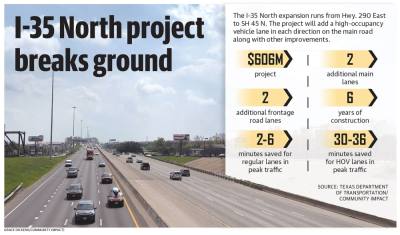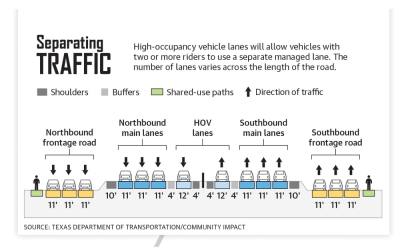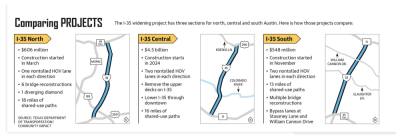Slated to add a main lane in each direction, create a diverging diamond interchange and expand frontage roads, the project on I-35 from Hwy. 290 East to SH 45 N has raised concerns for residents and businesses throughout the project who ultimately look forward to its completion in 2029.
“We know the project is coming whether we like it or not, but one of the biggest concerns is how we can be ready,” said Margaret McGhee-Sufke, Wells Branch Neighborhood Association president. “Being prepared and knowing ahead of time how to be reactive to it and planning is going to be huge.”
Though work began in mid-March, the official project groundbreaking occurred March 29, after press time.
Plan for relief
The need for the project arose from studies showing I-35 as one of the most-congested roads in Texas, said Bradley Wheelis, a public information officer for the Texas Department of Transportation. Project funding was approved in September and comes from TxDOT and the Capital Area Metropolitan Planning Organization, the region’s transportation planning group.
The largest change on the way with the I-35 North project includes the addition of a nontolled high-occupancy vehicle lane in each direction. That lane is intended for use by individuals carpooling, emergency service vehicles and buses. This will result in 30-36 minutes saved for HOV lane users in peak traffic times, according to TxDOT.
The project will also add a lane to the north- and southbound frontage roads along the length of the project. Roughly 18 miles of shared-use paths will be built beside most of I-35’s frontage roads for use by non-motorists.
Additionally, the I-35 North project will reconstruct six bridges with pedestrian and bicycle paths at Grand Avenue Parkway, Wells Branch Parkway, Howard Lane, Walnut Creek, Braker Lane and Rundberg Lane. Bypass roads will also be built near several intersections. These roads allow drivers to navigate from the frontage road to a lane along I-35 to skip intersections facing congestion on the frontage roads.
Along with a new bridge, TxDOT will build a diverging diamond interchange at Wells Branch Parkway. The interchange allows large amounts of turning traffic to turn at once by diverting drivers to the opposite side of the road for a short distance, Wheelis said. This interchange will run under the bridge, allowing cross-street traffic to enter I-35 more easily.
“With [these interchanges], you can move more vehicles through a single signal cycle than a traditional intersection, and that helps move a lot of left-turning traffic,” Wheelis said.
Rethink35 is a volunteer-based organization with chapters from San Antonio to Georgetown dedicated to protesting the I-35 expansion projects. Round Rock chapter founder Benjamin Berg said the project will not pay off in the way public officials have promised.
“When you’re adding more lanes, you’re not necessarily relieving the area,” Berg said. “Investing in forms of transportation that are public and easily accessible is a better alternative to put money back in people’s pockets and allow for quicker transportation.”
Bracing for impact
The I-35 North project has been in the works since at least 2016, when TxDOT held its first public meeting about the event for residents to attend, followed by several more public meetings leading up to the project’s approval and start.
While residents such as McGhee-Sufke in Wells Branch remember these initial conversations with TxDOT, she said many newer residents to the area were unaware the project was coming.
“In one camp ... [people] are concerned about safety and learning how to navigate [the diverging diamond],” McGhee-Sufke said. “The other camp of people can’t wait for it to get here.”
Despite the downsides of construction, some residents are anticipating the improvements, said Robert Meadows, Walnut Creek Neighborhood Association president.
“We don’t look forward to the chaos, ... but we look forward to having our interchange at Braker and I-35 be built to much better standards, and we look forward to having the sidewalks,” Meadows said.
The I-35 North project is one of three in Central Texas intended to curb congestion and improve mobility alongside the I-35 Central and I-35 South projects. While the Central project will displace an estimated 291 homes and businesses, the North section of the project will not displace home or business owners, according to TxDOT.
While not being displaced, businesses owners in the area said they believe they will be affected by construction, French Quarter Grille owner Scott Stolle said. French Quarter Grille is located near Parmer Lane, where a diverging diamond interchange was completed in June.
“They will allow this incredible growth to continue onward not realizing that the infrastructure is going to suffer,” Stolle said. “The bottom line is this will affect my business, but we have so many loyal guests.”
Similarly, Robert Ronan, head coach and owner of Austin Barbell Club near Braker Lane, said construction is never easy for business owners. He lived through the MoPac expansion that added toll lanes in each direction years prior in his Central Austin location.
“Any small-business owner that’s trying to navigate the Austin landscape, the growth, the changes—it’s always a challenge, so you just have to be nimble and pivot when the city does,” Ronan said.••Road work ahead
Phase 1 for I-35 North involves widening north- and southbound main lanes, installing a new center median barrier, reconstructing the Braker Lane bridge, and constructing a new northbound frontage road over Walnut Creek, according to TxDOT.
With Austin’s population estimated to double by 2045, transportation organizations must find a way to keep up with demand, Wheelis said.
Though the project started in March, timelines for phases of the project have not been established, Wheelis said. The most disruptive construction involving lane closures will mostly happen overnight to prevent problems for residents where possible, Wheelis said.
Regardless of the pain of construction now, Meadows with the Walnut Creek Neighborhood Association said the project will pay off in the end; residents just have to hold on until then.
“It’s going to be a tremendous amount of construction that, on the whole, we look forward to as a neighborhood,” Meadows said. “Hopefully at the end of it, traffic will move, and things will be better.”
Brian Rash contributed to this report.










